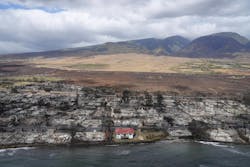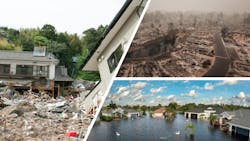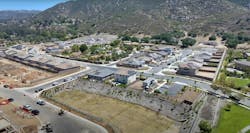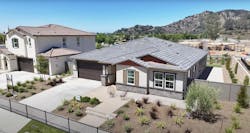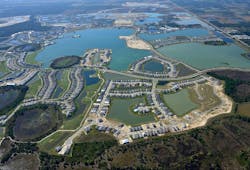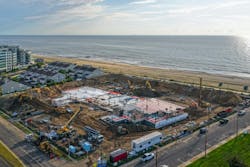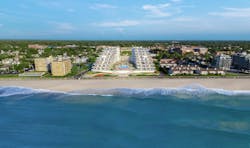Special Report: Defining & Delivering Resiliency
This article first appeared in the September/October issue of Pro Builder
What does resiliency look like?
Is it the “miracle house” on Maui that somehow survived the wildfire that wiped out more than 2,200 homes in 2023? Or Babcock Ranch in Southwest Florida, an extensive mixed-use master-planned community that sustained no structural damage, flooding, or service outages when Hurricane Ian sat on top of it for eight hours in 2022?
Is it teaching homeowners how to care for their property and better prepare for natural disasters, retrofitting millions of existing homes against climate risks, or applying a set of voluntary standards that measurably reduce damage from a variety of events?
How about building homes that can be insured in high-risk areas or communities that are designed and built to rebound more quickly from a hurricane, tornado, or wildfire? The answer is all of the above, and more.
As the frequency and severity of hurricanes and tornadoes, storm surges and flooding, wildland-urban interface wildfires, and even droughts, ice storms, and earthquakes increase, the need to design, engineer, innovate, develop, and build to higher standards becomes more critical and necessary.
Fortunately, the tools are there, easily accessible, real-world proven, and, for the most part, inexpensive—especially when you consider the costs of rebuilding that more frequently breach a billion dollars per event. And that’s just for property damage, never mind the long-term economic impacts on employment, education, tax rolls, and out-migration. And the thousands of lives lost.
"If somebody’s home survived but everything around it was destroyed, including businesses and schools and where they shop, you haven’t achieved resilience," says Alex Cary, director of market development for the Insurance Institute for Business & Home Safety’s (IBHS) Fortified Home program. “Resiliency is truly reducing the extent of damage so life can resume quickly, and the overall economic impact is as low as possible.”
The Big Picture
According to the National Centers for Environmental Information (NCEI), from 1980 to 2024 there were 403 confirmed weather events in the U.S. with property losses exceeding $1 billion each. In that 44-year span, the average was nine such events per year; since 2020, the average is 23.
A recent report from property data provider Cotality estimates there are currently 33.1 million homes at risk of hurricane damage spanning the East Coast at a combined estimated reconstruction cost of $11.7 trillion.
The firm also counts nearly 2.6 million homes across the U.S. at moderate or greater risk of wildfire with a collective reconstruction cost of $1.3 trillion. Since 2020, at least 10 major wildfire-induced conflagrations, from Colorado to Southern California to Maui, have destroyed more than 26,000 structures.
And, earthquakes cause an average of $14.7 billion in annual property losses in the U.S., according to a 2023 report from the Federal Emergency Management Agency (FEMA).
In large part a result of both recent incidents and future risk factors, property insurance rates have spiked 40.4% in the past six years, raising the average annual cost of home insurance across the U.S. to $2,801, about 10% of total household expenses.
For builders and developers interested in providing genuinely “hardened” homes and communities, there is a clear roadmap (and ample real-world examples) of how to get there, from knowing the risks of a given building site and following the protocols of above-code certification programs to systems thinking and effective marketing.
Know The Risks
Assessing risk begins with the location of a home or community. While coastal areas, development that borders forestland, and the open plains seem obvious, and are historically the primary hotspots, the threat of natural disasters is becoming more geographically widespread. And more varied, such as ice storms in Texas, droughts in Georgia, and flooding in western North Carolina.
For Dixon Trail, a 64-unit project in Escondido, Calif., Steve Ruffner, president and regional general manager at KB Home, knew the project was in a high-risk wildfire zone when he came across IBHS’ Wildfire Protected Home above-code certification program, which he leveraged into a neighborhood-wide designation.
The experience gave him and KB Home a broader perspective on assessing risk. “People ask me how close to a high-risk zone should you build to these standards, and I tell them probably within 5 miles,” he says.
In Louisiana, infamous for hurricanes, there are “everyday” threats that are no less impactful, if rarely headline-worthy. “Humidity is the biggest factor down here,” says Brett Hallstead, director or projects at lowernine.org, a non-profit helping to restore and stabilize the Lower Ninth Ward of New Orleans still suffering the effects of Hurricane Katrina in 2005. “Older houses here were designed to breathe,” a vernacular design practice that allowed moisture vapor to passively enter and exit indoor spaces of essentially neutral relative humidity without causing latent problems.
But the advent of air conditioning and tight-home building codes pulled in and trapped moisture vapor, leading to rot and mold that affected both structural integrity and occupant health. “So, you have to build in very, very smart ways and with the right materials to make sure that balance is there,” he says.
Other risk tips to keep in mind: If flying embers from a wildfire ignite a home, there’s a 90% chance it will be destroyed with or without firefighter intervention. Losses caused by trees felled by high winds contribute heavily to property damage, while those planted and allowed to grow closer than 5 feet from a home fuel wildfire events. Roofs are the most vulnerable area in a hurricane or tropical storm, and once water gets into the living spaces, the home is likely a total loss.
Metal roofs and fenestration frames are often touted as the best choice to limit flame spread, but don’t perform the same in a fire event.
“The melting temperature of aluminum is about 900 to 1,200 degrees Fahrenheit, while copper is approximately 2,000 degrees and steel is north of 2,600 degrees,” says Dick Davis, a former fire engineer and technical specialist at FM Global, a global property insurance provider. Actual flame temperatures in houses vary from 1,000 to 2,000 degrees, he says.
Here’s another fun fact: Once a hurricane is named, insurance carriers issue a moratorium that freezes a homeowner’s ability to adjust coverage or buy a new policy.
Take a Broader Approach
To be sure, most builders have little to no control beyond the homes they build; resilience across a new community of multiple builders or within an existing community is out of their scope of influence.
But by the same token, approaching a new build that will perform better requires a broader, systems-level mindset, as well as a willingness to go above code-minimum standards.
“Consider the entire building envelope and its surroundings to protect the structure from wildfire exposure,” says Davis. “Codes are minimum requirements. There’s nothing wrong with exceeding those requirements.”
Babcock Ranch is the poster child for community-wide resiliency. Developer Kitson & Partners spearheaded a holistic effort that includes on-site power and water utilities run underground to serve 20,000 homes and 6 million square feet of commercial space at build-out.
The development work also restored natural water retention and flow through the 18,000-acre property and planted native landscape materials that better withstand storms and support a broader interpretation of resilience.
“We got eight hours of continuous rain (from Hurricane Ida), and a lot of it went down the natural flow, and didn’t end up in our lakes or in our wetlands and kept off the roads,” says Tom Hoban, Kitson’s president and CIO. “If you stop and listen to Mother Nature, she’ll tell you a lot, and she’s got a pretty good track record.”
The developer also required its home builders, among them Lennar, Pulte Homes, D.R. Horton, Meritage Homes, Toll Brothers, and Dream Finders, to achieve no less than a bronze level of Florida Green Building Coalition standards, which is slightly better than the Miami-Dade County building code, arguably the most stringent set of standards in the country.
“Our vision of sustainability and resilience were the pillars that we needed to get right if we wanted to create a town that would endure multi-decades of growth,” Hoban says.
And while every dwelling at KB Home’s Dixon Trail will be certified under the IBHS’ Wildfire Protected Home standards, along with additional state requirements for high-risk areas, “I wanted to designate the whole community because I thought it would help us with insurance underwriters and give our homebuyers peace of mind in a high fire zone,” Ruffner says, which it did on both counts.
Even then, the builder went beyond, codifying the program’s design guidelines in the community’s CC&Rs and funding IBHS’ annual recertification process for three years.
Are Today’s Building Codes Enough?
Arguably, the roughly 119 million homes built before 2010 suggest that retrofitting the existing housing stock should be a higher priority to achieve resiliency than boosting the building codes for new homes already built to more stringent standards.
“Sometimes just ensuring that the homes are actually built to code, a good code, can make a home more resilient,” says Michelle Foster, VP of Sustainability and leader of the National Green Building Standard (NGBS), a voluntary above-code certification program that added a resiliency aspect in 2022 and will offer a more pragmatic approach in its 2025 version.
In theory, yes, but IBHS’ efforts to roof and reroof homes in Louisiana and Alabama to Fortified standards exposed cracks in modern code enforcement. “Even when (a more robust roofing specification) is in the code, roofs are just not inspected very often,” says IBHS’ Alex Cary, and thus more vulnerable to severe damage, total loss, and high replacement costs.
To ensure compliance for both NGBS +Resilience and IBHS Fortified and Wildfire Protected standards, those programs hire, train, and certify independent evaluators to inspect, gather documentation, take photos, and otherwise audit every single house.
“Third-party verification really is key,” she says, and has proven to be a differentiator in terms of reducing damage and cost after a weather, fire, or seismic event.
Others are less tolerant. “You cannot rely on the existing codes and standards,” to respond to the increasing frequency and severity of natural disasters, says former fire engineer Dick Davis. “I don’t like to put too much reliance on waiting for the codes to change to solve all the problems.” —R.B.
Build Better
Simple, not simple ... or is it?
“We’re just pointing out the materials that are already out there in the market with testing standards applied to them,” says Cary, “so it’s just the simple fact of paying attention to what you’re using.”
Adds architect Travis Hendrix, an associate principal at KGA Studio Architects in Denver, “Let’s start with the basics and just make sure that the siding stays on in a windstorm or isn’t combustible,” he says. “We don’t need a Ferrari. We need a Honda Accord.”
That “miracle house” on Maui? No doubt luck and perhaps a shift in the winds played a part in preserving it, but during a recent renovation the owners hardened the home with a commercial-grade steel roof and replaced overgrown landscaping against the house with a meter-wide swath of river stones. The result was an effective defensible space, a key factor in determining a home’s fate in a wildfire.
Graham Davis, a Colorado-based building performance specialist for IBACOS, applied a variety of off-the-shelf products and proven practices when rebuilding his family home in Colorado after a wildfire took out his neighborhood in 2015.
His spec list included a steel roof, fiber cement and manufactured stone exterior claddings, and eliminating attic ventilation (a common entry point for flying embers) by insulating the roof structure and conditioning that space.
He also lifted the house 3 feet above grade to mitigate ignition from ground-level fires and created proper defensible space around the structure.
Other common (and relatively low- or no-cost) best practices include non-combustible fencing material (and vented designs in high-wind zones); waterproof and/or fire-resistant underlayment over the roof deck with joints securely taped; dual-paned or better windows and glass doors, ideally with metal frames; wind- and fire-rated garage doors, anchored roof finishes, and exterior claddings; metal gutters and downspouts; wind-driven water- and ember-blocking soffit vents; gable end bracing; properly anchored chimneys fitted with spark arrestors; and a continuous load path from the roof to the foundation.
The cost premium to build a single-family home above code to formal or informal standards appears marginal. IBHS estimates that meeting its Fortified Gold standards (the highest level of three options) increases construction costs from 0.5% to 3% for new construction. And innovation is on the way.
At both Veridian at County Farm in Ann Arbor, Mich., and Blatchford Lands in Edmonton, Alb., among a growing number of other new master-planned communities, microgrid virtual power plants relying on solar with battery backup provide daily and emergency power and peak energy use and demand response management while reducing carbon emissions.
Meanwhile, the Fire Lab at the Home Innovation Research Labs offers a battery of tests to not only confirm compliance with recognized certification standards, but also to gauge various fire-resistant qualities for products still in the development pipeline.
Recent examples include walls systems with spray-foam insulation integrated into the studs; hemp-based, vacuum-insulated panels; and thermally modified wood that enhances structural capabilities, among other wannabe “non-combustible” materials.
“I’m not sure what their secret sauce is, but we can tell them when it ignites,” says Michael Luzier, Home Innovation’s president and CEO.
Sell It
Before resilient construction and communities are put in front of would-be homebuyers, getting builders and developers on board with above-code standards and even the idea of resiliency can be a hard sell in itself.
“It’s more difficult because a lot of things that you can do for resilience help the homeowner, but don’t necessarily benefit the developer or the home builder directly,” says Bill Ramsey, a principal at KTGY in Denver. “And unless they’ve personally been affected by a fire, I think there’s a bit of ‘It’ll never happen to me’ going on.”
One recent inroad might be the prospect of lower property insurance rates granted to more (and qualified) resilient homes and neighborhoods, which benefits both builders and homeowners by alleviating at least one potential barrier to qualifying for a mortgage loan.
“The inability to get homeowner’s insurance is going to hit critical mass,” says Hendrix, “so at some point you’ll have to do it if you want to be able to sell at all.”
That was a key benefit for KB Home at Dixon Trail, as members of IBHS (read: property insurance providers) stepped up to underwrite those homes, reversing the tide of carriers abandoning the state. “The cost savings for the insurance was a big win for homeowners, and the payback is incredible,” says Ruffner.
KB Home also made it a priority to build awareness and value in its Wildfire Protected Neighborhood among prospective homeowners.
“We trained the sales agents on the program before we opened. We trained the management company that runs the HOA for us, and we discuss it with buyers at their point of entry,” he says.
And occasionally, in some high-risk areas, the concept practically sells itself. “If you live in South Florida, you worry about your house getting blown away or your roof blowing off or having your windows or doors blown in,” says Hoban. “You’re worried about flooding and about losing power.”
And sometimes selling homes is almost beside the point because it’s not the ultimate goal.
“We can’t promise anything for certain, but we feel really good about the results of what happened during Hurricane Ian,” says Hoban. “And we’re encouraged by where innovation is going to help further fortify Babcock Ranch as a resilient community.”
Fiona Maguire-O’Shea contributed to this article.
Go here for a collection of building products engineered for resilience, and additional resources online.
About the Author

Rich Binsacca, Head of Content
Rich Binsacca is Head of Content of Pro Builder and Custom Builder media brands. He has reported and written about all aspects of the housing industry since 1987 and most recently was editor-in-chief of Pro Builder Media. [email protected]
